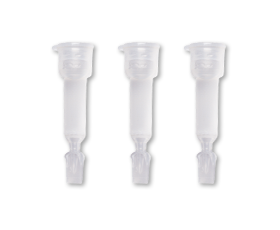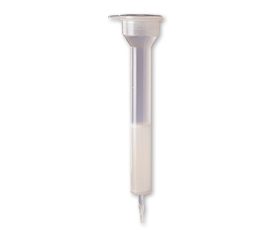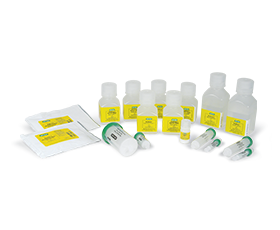Desalting Columns for Small Molecule Removal
Desalting columns use the principle of size exclusion chromatography, also called gel filtration chromatography. In addition to desalting, the other main use for size exclusion chromatography is size fractionation.
The matrix beads in a size exclusion column contain pores. If a molecule or compound can enter the pores, it will move through the column by a longer path than any molecule or complex that is too large to enter the pores. Molecules that do not enter the pores will move through the column with the mobile phase, whereas molecules that can enter pores will be retarded and elute after these larger molecules. The size exclusion limit is the upper range of molecular size that can enter the pores.
In desalting, there is a large size difference between the target molecules in the sample and unwanted salt or small molecules. A size exclusion limit is chosen that is lower than the size of the target molecules (that is, target molecules are too big to enter the pores of the beads). Therefore, they are excluded from the pores, remain in the mobile phase, and are eluted after the void volume. Salts and other small molecules are retarded by the desalting column and are thereby separated from the target molecules. Desalting is sometimes called group separation mode.
In fractionation by size, all the molecules to be separated are below the size exclusion limit of the column, and are retained by the column. The amount of retardation of each molecule is related to its size (and shape). This results in sequential elution of the molecules by size.
The two types of size exclusion chromatography require different columns. Desalting columns have packing and dimensions that allow for elution of the excluded molecules just before one column volume of mobile phase has passed through the column. Therefore, a desalting column is usually short and broad, whereas for size fractionation, the longer the column, the higher the resolution.
Bio-Rad has an extensive range of both fractionating and desalting columns. The next sections describe uses and selection of desalting columns.
Desalting Column Uses
Desalting columns are used with both proteins and nucleic acids. They provide a fast, simple way to purify these biomolecules away from salts and small molecules. Common uses of desalting columns include:
- Removal of salts
- Removal of low molecular weight molecules, for example cofactors, inhibitors, and contaminants
- Buffer exchange
- Stopping reactions between macromolecules and low molecular weight reactants
- Removal of unreacted radioisotope from a sample
- Removal of primers and primer-dimers from PCR reactions
- Removal of dNTPs and other nucleotides
- Removal of dye terminator from sequencing reactions
Desalting Column Selection
Bio-Rad has a wide choice of desalting columns in gravity, spin, and pressure-compatible formats. There is a column for every use and for a range of sample sizes. Many columns are available pre-equilibrated with Tris or SSC. Additionally, for riboprobe cleanup, there are columns pre-equilibrated with ribonuclease-free buffer.
When desalting protein solutions, the molecular weight exclusion limit of the desalting column used must be considered. Columns with a 6,000 Da size exclusion limit (globular proteins) are used for most applications. When using this type of desalting column, in addition to removing salts and other compounds, only nucleotides, small peptides, and nucleic acids will be retained by the column.
Desalting columns are available with a 40,000 Da size exclusion limit. This allows for larger proteins to be retained on the column. For a protein complex or large protein of interest, these columns can be used to remove larger contaminants.
In addition to desalting and buffer exchange for proteins, we offer a range of desalting columns optimized for various molecular biology techniques. Check out our selection guides to determine the optimal columns for your protocols.




